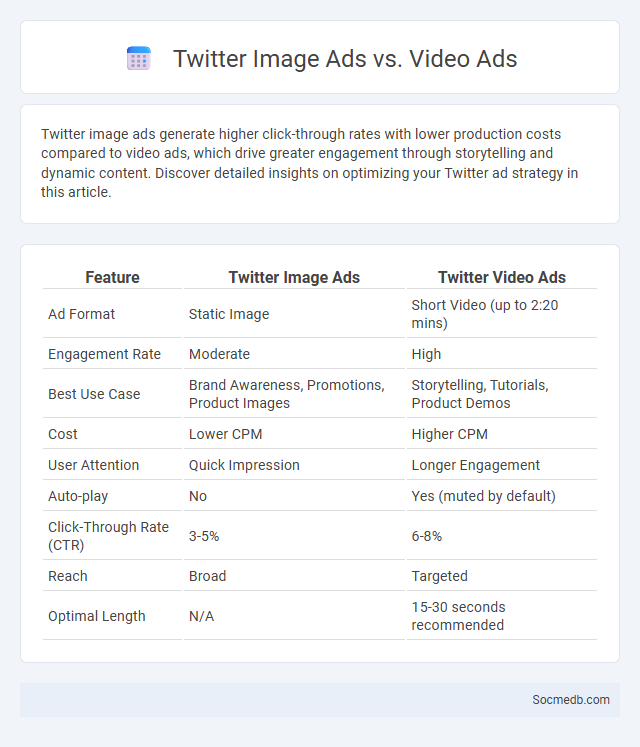
Photo illustration: Twitter Image Ads vs Video Ads
Twitter image ads generate higher click-through rates with lower production costs compared to video ads, which drive greater engagement through storytelling and dynamic content. Discover detailed insights on optimizing your Twitter ad strategy in this article.
Table of Comparison
| Feature | Twitter Image Ads | Twitter Video Ads |
|---|---|---|
| Ad Format | Static Image | Short Video (up to 2:20 mins) |
| Engagement Rate | Moderate | High |
| Best Use Case | Brand Awareness, Promotions, Product Images | Storytelling, Tutorials, Product Demos |
| Cost | Lower CPM | Higher CPM |
| User Attention | Quick Impression | Longer Engagement |
| Auto-play | No | Yes (muted by default) |
| Click-Through Rate (CTR) | 3-5% | 6-8% |
| Reach | Broad | Targeted |
| Optimal Length | N/A | 15-30 seconds recommended |
Introduction to Twitter Image Ads, Video Ads, and Ad Campaigns
Twitter image ads leverage visually engaging photos to capture user attention and enhance brand visibility within targeted timelines. Video ads on Twitter offer dynamic storytelling opportunities through short, compelling clips that increase viewer engagement and drive higher interaction rates. Ad campaigns integrate these formats strategically, utilizing Twitter's robust targeting tools and analytics to optimize reach, maximize conversions, and refine audience segmentation for improved ROI.
Key Features of Twitter Image Ads
Twitter Image Ads stand out with their high-resolution visuals that capture attention in fast-scrolling feeds, increasing engagement rates significantly. They support clickable images that drive traffic directly to your website, product page, or app, enhancing conversion opportunities for your brand. You benefit from customizable call-to-action buttons and detailed targeting options, ensuring your message reaches the most relevant audience.
Key Features of Twitter Video Ads
Twitter video ads offer powerful targeting options, including audience demographics, interests, and keywords, ensuring your message reaches the right viewers. These ads support various formats such as Promoted Video, Video Website Cards, and In-Stream Video, maximizing engagement through autoplay and sound-on features. Your brand can leverage real-time analytics and tweet performance metrics to optimize campaigns and boost ROI effectively.
Understanding Twitter Ad Campaign Structures
Twitter ad campaign structures consist of three key elements: campaign, ad group, and tweet ads, each designed to optimize targeting and budget allocation. Campaign objectives are chosen based on your marketing goals, such as brand awareness, website traffic, or conversions, which guide the ad delivery strategy. Effective management of bids, budgets, and audience segmentation within ad groups ensures your ads reach the most relevant users, maximizing engagement and return on investment.
Comparing Engagement Rates: Image Ads vs Video Ads
Image ads typically yield higher engagement rates on platforms like Instagram due to their quick visual impact and ease of consumption. Video ads, while often generating deeper user interaction and longer watch times on platforms such as Facebook and TikTok, may require more attention and time from your audience. Choosing between image and video ads depends on your campaign goals, with image ads ideal for immediate clicks and video ads better suited for storytelling and brand awareness.
Cost Analysis: Image Ads vs Video Ads vs Campaigns
Image ads typically have lower production costs and faster deployment times compared to video ads, which require higher expenses for filming, editing, and post-production. Video ads often yield higher engagement rates and brand recall but demand a larger budget for creative development and distribution, impacting overall campaign costs significantly. Comprehensive campaign cost analysis must consider ad format expenses, targeting efficiency, and performance metrics to optimize return on investment across social media platforms.
Audience Targeting Capabilities
Social media platforms offer advanced audience targeting capabilities, allowing you to reach specific demographics based on age, location, interests, and behaviors. These sophisticated filters help maximize campaign effectiveness by delivering content to users most likely to engage with your brand. Leveraging these tools ensures your marketing efforts generate higher conversion rates and improve ROI.
Creative Best Practices for Image and Video Ads
Utilizing high-resolution visuals and engaging storytelling techniques enhances user interaction in social media image and video ads. Incorporating brand colors, clear call-to-actions, and mobile-friendly formats increases ad recall and click-through rates. Testing multiple creative versions helps identify top-performing content, maximizing campaign effectiveness and ROI.
Measuring ROI: Performance Metrics for Each Ad Type
Tracking key performance metrics like click-through rates (CTR), conversion rates, and cost per acquisition (CPA) allows you to accurately measure ROI for different social media ad types. Engagement metrics such as likes, shares, and comments provide insight into brand awareness, while lead generation ads require monitoring form submissions and qualified leads. Tailoring measurement to each ad format ensures your marketing budget delivers maximum impact and drives business growth.
Choosing the Best Twitter Ad Format for Your Goals
Selecting the best Twitter ad format depends on campaign objectives such as brand awareness, engagement, or conversions. Promoted Tweets enhance visibility with images or videos, while Twitter Cards drive website traffic and app installs through rich media. For direct response goals, Twitter's Lead Generation Cards capture user information seamlessly within the platform.
 socmedb.com
socmedb.com